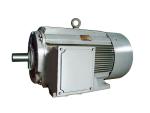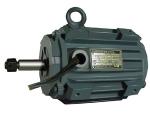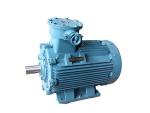Before installation
1. Check the rated power, voltage, frequency and speed to see if they are consistent with specifications.
2. Inspect all parts carefully to ensure they are in good condition. If any part is loose, rotate the industrial motor by hand to check if there is any clogging.
3. Measure the insulation resistance of phase to phase windings and between windings with a 500V megger. During operation, the measured value should not be less than 1MΩ.
Installation
1. Install marine motors in a well-ventilated environment. The clearance of the fan cover’s inlet wind ending must not be less than the specified value on Table 1.
| Frame Size | Y-H56 ~ 132 | Y-H160 ~ 180 | Y-H200~Y-H450 |
| Clearance | 25 | 30 | 50 |
2. The cable gland of the marine terminal box can be changed from three directions except the shaft extension side. If the direction of the cable gland needs to change, the terminal box can be moved by removing four symmetrical bolts on the box.
3. Punch holes on the rubber padding inside the cable gland and connect winding. Packing nuts must be screwed up to be waterproof and shockproof.
4. After installing, check all the fixing and joint parts. The rotor must rotate freely without clogging when rotated by hand.
Running a Trial Operation
1. Six terminals on each motor are marked U1, V1, W1, U2, V2, and W2. Lead wires must be connected according to the connecting diagram marked on the connecting plate.
2. After the connection is finished, no load test may be carried out. If the rotation direction of the motor is different from the driven machine, two of the main wires must be exchanged after the motor is stopped. When the speed reaches its rating in the first trial run, stop the motor and check if any of the joint parts are loose. After readjusting, do not carry out a load test for another two to three hours. If any abnormal sound occurs, stop the motor. Check if it has overheated or oil has leaked.
3. During operation, observe if starting conditions and sound are normal and if the load current goes beyond the rated value. After running 0.5-1 hour, stop the motor and see if the coupling has overheated or oil leaked out. If not, then the motor can be used normally.
4. The motor should start with full voltage. Reduced voltage starting can be adopted if the decrease in starting torque is proportional to the square of the voltage drop . A Y-△ starter or a compensator is normally used for starting with reduced voltage.
5. Check that the working time of fan is prolonged for an hour, that is after the motor is power off, the fan keep operating an hour then it could stop.
Service, Maintenance and Storage
1. The motor must operate according to the ratings on the nameplate and should not be overloaded.
2. Readings for temperature and inspection results should always be noted during operation. How problems are treated should also be kept for future reference.
3. The ventilator channel should be unblocked and heat sources must not be placed near the motor.
4. Except for Y80~132-H, bearings are sealed so there is no need to add grease. Y160-H motors are equipped with grease filling and draining devices. You can remove the front and rear filling screw plugs to fill a grease gun if necessary.
5. Lubrication for bearings should be lithium base No.2. Change the lubrication every 6 months, if the color has darkened or if the bearings are wet, overheated, or dusting. New lubrication should cover 2/3 of the whole bearing room.
6. Periodic inspection will help prevent accidents. General marine motor maintenance should be done every three months and an overhaul every year. General maintenance includes cleaning dust and dirt away from the external body and cleaning and drying the connecting plate. Inspect connections for insulation resistance in windings and terminal and grounding cable connections, and tighten joints of fixing parts and the drive mechanism. An overhaul includes disassembling the motor and checking the windings’ condition and any damage to the end bindings. Also clean the inside and outside of the body and check the motor’s bearing, greasing as needed.
Drying
1. A damp motor must be dried before using.
2. A motor eroded by seawater must be washed with fresh water before drying.
3. When drying, motors must not be heated over 100℃ and drying should last for about four hours.
| No. | Trouble | Causes | Solutions |
| 1 | Motor starts without noise nor vibration | One phase is open circuit | Find the broken points and connect them |
| 2 | Motor rotates noisily and overheats | Winding is short circuited | Repair the winding |
| 3 | Low speed after starting | (1) Beginning and end terminals of phase winding are misconnected (2) Applied voltage is too low |
(1) Find out the beginning and end terminals of every phase and connect them in a correct way (2) Check power voltage |
| 4 | Insulation resistance is too low | Winding is dirty or damp | Clean the motor and dry the winding |
| 5 | Rapid temperature increase of the winding | Overloaded | Reduce the load and check other parts |
| 6 | Bearing overheats | (1) The motor is eccentric with load connection or the belt tension is too high (2) Bearing is damaged |
(1) Check concentricity or reduce belt’s tension (2) Replace the bearing |
| 7 | Bearing sounds abnormal | (1) Bearing is damaged (2) Bearing is dirty or not greased |
(1) Replace the bearing (2) Refresh the grease |
| 8 | The motor vibrates | (1) The coupling may be unbalanced (2) Incorrectly mounted, unbalanced, or too rigid (3) The motor’s shaft may be eccentric with the mechanical shaft. |
(1) Check balance (2) Check installation or frame (3) Correct concentricity |
Guarantee Period
We guarantee the motor will perform in a good condition for one year (within two years of the nameplate date) if operated and stored correctly. We will repair motors or replace spare parts that aren’t working due to poor quality of the motors.

 English
English Русский
Русский العربية
العربية


